Structural and biochemical characterization of the human cyclophilin family of peptidyl-prolyl isomerases
- PMID: 20676357
- PMCID: PMC2911226
- DOI: 10.1371/journal.pbio.1000439
Structural and biochemical characterization of the human cyclophilin family of peptidyl-prolyl isomerases
Abstract
Peptidyl-prolyl isomerases catalyze the conversion between cis and trans isomers of proline. The cyclophilin family of peptidyl-prolyl isomerases is well known for being the target of the immunosuppressive drug cyclosporin, used to combat organ transplant rejection. There is great interest in both the substrate specificity of these enzymes and the design of isoform-selective ligands for them. However, the dearth of available data for individual family members inhibits attempts to design drug specificity; additionally, in order to define physiological functions for the cyclophilins, definitive isoform characterization is required. In the current study, enzymatic activity was assayed for 15 of the 17 human cyclophilin isomerase domains, and binding to the cyclosporin scaffold was tested. In order to rationalize the observed isoform diversity, the high-resolution crystallographic structures of seven cyclophilin domains were determined. These models, combined with seven previously solved cyclophilin isoforms, provide the basis for a family-wide structure:function analysis. Detailed structural analysis of the human cyclophilin isomerase explains why cyclophilin activity against short peptides is correlated with an ability to ligate cyclosporin and why certain isoforms are not competent for either activity. In addition, we find that regions of the isomerase domain outside the proline-binding surface impart isoform specificity for both in vivo substrates and drug design. We hypothesize that there is a well-defined molecular surface corresponding to the substrate-binding S2 position that is a site of diversity in the cyclophilin family. Computational simulations of substrate binding in this region support our observations. Our data indicate that unique isoform determinants exist that may be exploited for development of selective ligands and suggest that the currently available small-molecule and peptide-based ligands for this class of enzyme are insufficient for isoform specificity.
Conflict of interest statement
The authors have declared that no competing interests exist.
Figures
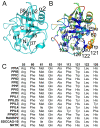
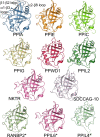
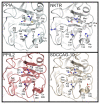

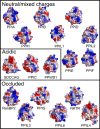
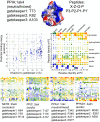
References
-
- Fischer G, Wittmann-Liebold B, Lang K, Kiefhaber T, Schmid F. X. Cyclophilin and peptidyl-prolyl cis-trans isomerase are probably identical proteins. Nature. 1989;337:476–478. - PubMed
-
- Takahashi N, Hayano T, Suzuki M. Peptidyl-prolyl cis-trans isomerase is the cyclosporin A-binding protein cyclophilin. Nature. 1989;337:473–475. - PubMed
-
- McKeon F. When worlds collide: immunosuppressants meet protein phosphatases. Cell. 1991;66:823–826. - PubMed
-
- Schreiber S. L. Chemistry and biology of the immunophilins and their immunosuppressive ligands. Science. 1991;251:283–287. - PubMed
Publication types
MeSH terms
Substances
Grants and funding
LinkOut - more resources
Full Text Sources
Other Literature Sources
Molecular Biology Databases
Research Materials

